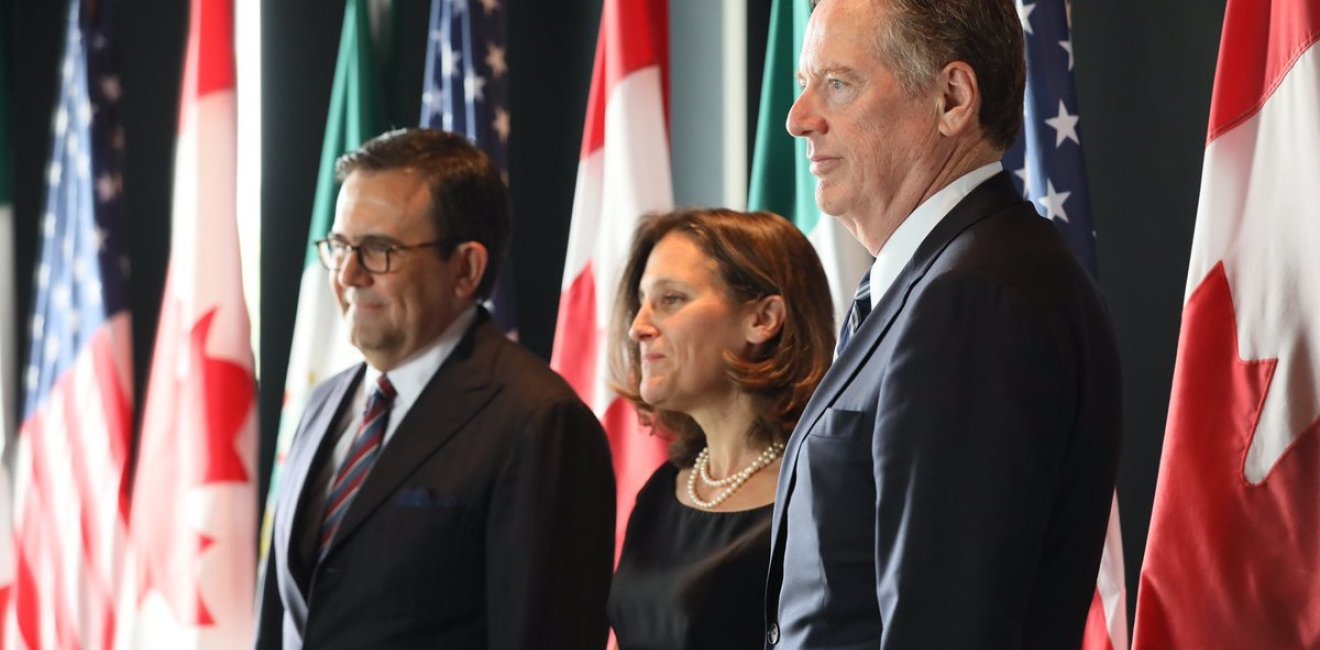The New NAFTA: Congratulations in Order, More Dealmaking Ahead
The Wilson Center’s experts on North America and international trade provide a first-take analysis of the hard-won deal that aims to reshape key aspects of continental commerce.
The Wilson Center’s experts on North America and international trade provide a first-take analysis of the hard-won deal that aims to reshape key aspects of continental commerce.

The Wilson Center’s experts on North America and international trade provide a first-take analysis of the hard-won deal that aims to reshape key aspects of continental commerce:
Laura Dawson, Canada Institute Director
The newly renegotiated NAFTA (USMCA) will do much to restore investor confidence in the North American economy. Negotiators from all three countries are to be congratulated for working through a complex deal that provides benefits for all three economies and the region as a whole. In particular, the United States negotiators showed their willingness to walk back from extreme positions in exchange for progress in priority areas. The Canadians demonstrated that slow, steady, and methodical was the best way through 34 chapters of complex negotiating text. And Mexico showed real leadership in its willingness to keep the agreement on a smooth path between one political administration and next.
The modernization elements of the USMCA are strong and largely meet or exceed the provisions of the original Trans-Pacific Partnership. Most of the divisive issues, such as the sunset clause and elimination of dispute settlement options, have been watered down or returned to the status quo.
A problematic element of the new agreement is the normalization of very high national security tariffs as a tool of compliance. Since the U.S. imposed them on steel and aluminum this summer, we have seen them provoke allies into retaliatory trade wars that hurt consumers, manufacturers, and farmers. Not only did the USMCA not provide Canada and Mexico with relief from the national security tariffs currently in force, they could also be imposed in future to ensure that Canada and Mexico do not violate the terms of the new auto agreement.
Also, it is important to remember that a ‘victory’ at the negotiating table does not necessarily translate into gains for producers or consumers. The new auto deal and Canada’s retained dairy protections both have the potential to curb new investment and raise or maintain high consumer prices.
"With a negotiating text in hand, it remains to be seen whether the completed text can run the gauntlet of stakeholders and legislators through to successful implementation. While the negotiations have shifted out of the hands of trade officials, the dealmaking has only just begun.
Duncan Wood, Mexico Institute Director
Reason and a mutually beneficial outcome have prevailed; the deal appears to take care of Canada’s most deeply held concerns while opening its politically important dairy sector to competition. For the United States, a partial opening of Canada’s dairy markets combined with the opportunity to declare victory in the renegotiation process, will have to suffice as compensation for giving up on eliminating anti-dumping dispute resolution mechanisms.
There is going to be widespread celebration that the uncertainty is over, and that the three countries can move forward with the final text of the agreement. The new deal represents a significant modernization of the 1994 deal, often referred to as an 'old lady of FTAs.' The USMCA looks a lot more like an agreement for the 21st century.
Perhaps the biggest winner out of all of this torturous process of renegotiation will be Andrés Manuel López Obrador. The Mexican president-elect will inherit an economy that is stronger because of the deal, and one that will benefit from much greater investor confidence thanks to the continuation of market access and investor protections.
Most importantly, however, from the macro perspective, is that the competitiveness of the North American region has been advanced by the conclusion of the negotiations. Despite the high-stakes gamble played by the Trump administration and the collateral damage to good relations between the three countries caused by threats and complaints, the USMCA will stand the North American partners in good stead as they face outwards to the world and confront the challenge from Asia and beyond.
Christopher Wilson, Mexico Institute Deputy Director
After more than 13 months of negotiations, the United States, Mexico, and Canada have finally reached an agreement to update NAFTA and apparently rename it the United States-Mexico-Canada Agreement (USMCA). The most important achievements of the negotiations were to preserve the basic architecture of the agreement and its trilateral nature during a period of backlash to free trade and globalization. Beyond this, the agreement represents a mix of more managed trade, especially in the auto sector, and a modernization of the agreement, including new provisions relating to digital goods and intellectual property. It is difficult to say whether the USMCA is, at the end of the day, more NAFTA 0.8 or 2.0, but despite the new name, the most important thing is that NAFTA continues to exist.
At times in recent weeks, NAFTA appeared to be getting pulled apart at its seams, at risk of breaking into two bilateral arrangements. A series of last-minute compromises avoided that outcome, thereby protecting one of the most important achievements of the original NAFTA — the development of highly competitive regional supply chains that work to combine the comparative advantages of all three North American countries.
The cloud of uncertainty that hovered above the Mexican economy for the last two years as NAFTA was at risk is beginning to clear, but two important obstacles remain: The first is the passage of the agreement through the U.S. Congress, a task that will almost certainly take place after the November mid-term elections change the composition, and possibly control, of both chambers. Passing a trade agreement has always been a difficult task, and the polarized nature of modern Washington ensures that this time will be no exception. The second major remaining challenge has to do with the steel and aluminum tariffs imposed on Mexico and Canada (as well as other nations). These tariffs, as well as the retaliatory tariffs imposed on the U.S. by Canada and Mexico, remain in effect. Though these tariffs are being handled through separate negotiations, according to government officials, pressure may mount on Mexican and Canadian leaders to hold out on the final approval of NAFTA until the tariffs are withdrawn.
Earl Anthony Wayne, Mexico Institute Public Policy Fellow
The new U.S.-Mexico-Canada Agreement (USMCA) is a welcome step.
If approved by each country’s legislature, the agreement will dissolve the uncertainty that has hovered over North America’s commercial and production networks for the last two years. A new rules-based agreement can be a major plus for the 1.2 trillion dollar continental market.
It is very important now, however, to have good assessments of the potential results that will flow from the agreement. While President Trump lauds the potential job creation, others characterize the agreement as a mixed bag.
The agreement includes a “modernization” of the existing North American Free Trade Agreement (NAFTA), as well as innovations sought by the U.S.particularly in “rules of origin” for autos and other goods.
Each government can claim wins from the understandings forged, capped by the Sunday U.S.-Canada agreement.
The United States, Mexico and Canada each showed flexibility, dropping and modifying divisive proposals and accepting positions they initially resisted, including replacing the initial U.S. proposal for a five-year “sunset clause” with a review framework which will last at least 16 years.
Business and farm interests expressed support for an agreement that offers a stable framework and avoids chaotic alternatives. But the brutal negotiations left relations bruised and helped send public views of the U.S. plummeting in Canada and Mexico.
At this point, it is very important to hear assessments from “stakeholders” in the business, farm, labor and consumer sectors, as well as from trade and commercial experts. Of particular importance are the potential impacts to the auto sector.
In the United States, the International Trade Commission will also provide its assessment of the agreement. These groups should sound alarms about questionable or potentially harmful proposals in the texts.
At first glance, the fact sheets offered by the Office of the U.S. Trade Representative and other briefings indicate that the “modernization” aspects of the USMCA are as good as or slightly better than what was included the original Trans-Pacific Partnership accord (TPP), from which the U.S. withdrew in January 2017.
The widely shared goal in these three-party talks was to update NAFTA to include best practices, new technologies, lessons learned and important changes since the NAFTA negotiations in the early 1990s.
Covering internet commerce is a good example of the "modernization" the new USMCA text embodies, as are changes to better protect today’s intellectual property innovations.
The new agreement also massively revises “rules of origin” for defining what constitutes a “North American vehicle" eligible for duty-free trade. This was a major U.S. objective that was not pursued in the TPP.
U.S. officials argue that the new rules will preserve and create new U.S. manufacturing jobs. Independent analyses will be important to scrutinize possible impacts, however.
Critics worry that the new rules will be costly and cumbersome for U.S. automakers, that they will harm their ability to compete with international companies and that they will raise costs for U.S. consumers. Somequestion whether the new rules will add U.S. jobs.
Other parts of the treaty also deserve careful scrutiny. For example, unions and their supporters in Congress will examine what Mexico committed to do to improve workers’ rights and if the U.S. can enforce compliance with those commitments.
U.S. energy companies and other investors will examine how changes will affect their rights in Mexico, where reforms attracted billions of dollars in U.S. and international investment. The U.S. also added commitments to discourage currency manipulation and to inhibit a free-trade agreement with a non-market economy — both of which seem aimed at China.
From a Mexican perspective, the agreement allows outgoing President Pena Nieto to sign the agreement before he leaves office on Dec. 1. It will allow incoming President Lopez Obrador (AMLO) to start his six-year term with a fixed framework for economic relations with the U.S., which buys 80 percent of Mexico’s exports. He can thus focus on domestic reforms.
For Canada, the agreement similarly provides a stable environment with a neighbor that buys 75 percent of its exports and hosts massive Canadian investments. Prime Minister Justin Trudeau yielded a bit on dairy issues, but preserved key dispute settlement procedures. He has time to solidify support before national elections in 2019.
The text will be finalized in the weeks ahead before an official signing at the end of November. The legislatures of all three countries must then approve the agreement, with the U.S. Congress likely to consider it only in 2019.
The three governments still need to resolve the U.S. decision to impose “national security” tariffs on steel and aluminum from Canada and Mexico, which led those countries to apply retaliatory tariffs on billions of dollars’ worth of U.S. farm and manufactured products. Those tariffs weigh heavilyon key sectors in all three countries.
The new agreement faces big hurdles ahead, especially winning approval from the U.S. Congress. Stakeholders supporting the agreement will need to remain active to help that process.
Simultaneously, the U.S. needs to work at repairing the damage done to mutual confidence among the three countries after many months of bitter and often unfounded criticisms.
A new Pew survey found positive views of the U.S. sinking massively in both Mexico and Canada over the past two years. Only 32 percent of Mexicans and 39 percent of Canadians held favorable views of the U.S. this spring, according to Pew.
These are worrisome statistics when the U.S. needs cooperation from its neighbors on serious homeland security issues and other matters.
Finally, with agreement in North America and trade talks beginning with Europe and Japan, the U.S. should focus more attention on errant trade actors like China, working with partners.
In North America, governments and the private sector should also turn full attention to making North America stronger for the on-going competition against global commercial rivals, especially as the world’s economies face rapid technological transformations and disruptions ahead.
In the coming days and weeks, the Canada Institute and Mexico Institute will be providing analysis and a convening platform from which to examine the full implications of the new deal.





The mission of the Wilson Center's Canada Institute is to raise the level of knowledge of Canada in the United States, particularly within the Washington, DC policy community. Research projects, initiatives, podcasts, and publications cover contemporary Canada, US-Canadian relations, North American political economy, and Canada's global role as it intersects with US national interests. Read more


The Mexico Institute seeks to improve understanding, communication, and cooperation between Mexico and the United States by promoting original research, encouraging public discussion, and proposing policy options for enhancing the bilateral relationship. A binational Advisory Board, chaired by Luis Téllez and Earl Anthony Wayne, oversees the work of the Mexico Institute. Read more
